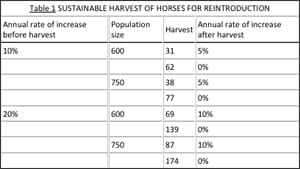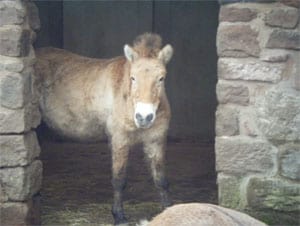By Philippa Jawando-Williams
Stretford Grammar School
Manchester, England

The Przewalski’s horse is the last remaining species of wild horse and is native to Mongolia. The conservation status of the Przewalski’s horse is critically endangered (ICUN 3.1) (1), and there are many reasons for this including loss of habitat and reduced gene diversity. Loss of habitat meant that it was more difficult for the wild horses to find food and water, so it was much more difficult for them to survive and their numbers gradually declined until they became extinct in the wild.
Wild horses are often found in cave paintings suggesting they were hunted by our ancestors. Many years later, the horse was not a valued food source. As more land was used for farming, they were driven from enclosures and forced further into remote areas, in the Dzungarian Gobi, a desert with few drinking places. Pumps were placed near the drinking places for humans, and these shy horses retreated again into even less habitable areas. These areas could not be cultivated, so there was less food available, increasing death rate. When the wild horses were discovered again in 1900, plans were made to catch them alive, as many wealthy people collected rare animals. It proved difficult to catch adult horses, so foals were caught and given domestic mares as ‘foster mothers’. After capturing and transporting 54 wild horses, many died and only 13 bred. This caused problems as in many zoos, a stallion would mate with his mare, then his daughter and sometimes his granddaughter. This caused inbreeding, which increased the chance of genetic diseases. This decreased the chance of a healthy foal being born, and so some died prematurely. Selective breeding to produce larger and stronger animals reduced the gene pool. A reduction in fitness was shown in successive generations and other genetic problems included underdeveloped ovaries and weak hindquarters. In the wild, these animals would die early and the disease would not spread however in zoos, the horses bred passing the disease to future generations. The extinction of the Przewalski’s horse in the wild was due to loss of habitat and hunting. However their greatest threat today is loss of genetic diversity.

The main goal of the Species Survival plan (SSP) is to ensure that the population of the wild horse remains as healthy and genetically diverse as possible. The SSP recommends breeding pairs, using calculations from match-making software. The least similar individuals are bred, achieving maximum gene diversity, so the offspring are less inbred and are more likely to survive in the wild. To achieve this, horses and genetic material are exchanged between zoos all over the world. Inbreeding of wild horses has decreased the fertility of individuals within the species and the behavioural changes that horses in captivity undergo mean that stallions cannot take possession of their mares. However, Dr. Sherman Silber has performed the first successful, reverse vasectomy on an equid. A sample of semen was collected from the wild horse, and will be injected into an egg of a suitable female. “I’ve always dreamed of using my expertise to contribute in some way to wildlife survival,” said Silber, 66. “It was also exciting to pioneer a new procedure for which humans were the ‘test animal.’” (4) Dr. Silber is an expert in fertility, and did the procedure in the same way as if done on a human.

This will infuse genetic diversity into the captive population, and help to prevent extinction. The Foundation for the Preservation and protection of the Przewalski’s Horse(FPPPH), has formulated a breeding programme using data from their own records and of inbreeding coefficients in order to minimise inbreeding. The foundation bought eight mares of different genetic backgrounds, and new genetic input is gained by using distantly related stallions from different zoos. As well as being selected for genetic criteria, the Przewalski’s horses are also inspected by veterinary surgeons for health, movement and vitality.

Both the SSP and the FPPPH, selectively breed these horses to increase genetic diversity, unlike the breeding of domestic horses for particular characteristics. Breeding programmes are designed to increase the population of the wild horse, and prevent any factors that could limit the population growth. For example adaptation is important for reintroduction of the wild horse into the wild. Initially, horses were immobilised whilst their hooves were trimmed, however the hooves now wear naturally. Other adaptations include forming stable social groups and creating behavioural patterns that would assist the horse’s survival in the wild such as getting food from under snow cover and self protection from midges and the wind. This increases the chance of the survival of a horse released into the wild; therefore it would be more likely to breed, increasing the population of these endangered animals. Releasing horses which are genetically diverse will expand the gene pool of those living in the wild, decreasing genetic diseases, increasing the life expectancy of the horses, again increasing the population growth. When the wild horse population reaches its maximum, and reproduction has stabilized some horses will be returned to zoos. Breeding program’s are designed to increase the population of the Przewalski’s horses without decreasing the genetic diversity of the species. Factors that affect genetic variation are genetic drift, selection (artificial or natural), mutation and migration. Breeding centres expand the gene pool by artificial selection.
The graph in figure 3 shows the rate of growth of the population of the Przewalski’s horse.The graph shows a growth rate of 10% or more per year. These growth rates can become quite vigorous and may need to be stabilised. The trend of the graph is clearly shown, the total number of wild horses increases with time, and is generally higher for mares.
Table 1 shows the number of horses that would be suitable for reintroduction to the wild. It appears that a system of both captive and wild populations of horses seems most effective. It should be possible to obtain harvests of horses without preventing the growth of the captive population or depriving the gene pool of essential variation.
Figure 3 and table 1 show that the solutions to this problem are effective as they increase the size of the population and attempt to remove any limiting factors.

There are disadvantages to breeding the Przewalski’s horse in captivity. Due to unconscious selection and living in captivity, the wild horse has lost its fright for humans, so when the horses are released, they will be more susceptible to hunting by local people which could have a devastating effect on the wild population. However, as local Kazak herders depend on the KNR for pasture, National zoo scientists have held training workshops and undertaken community surveys to determine the social economic needs of local herders. This will educate the local people on the horse, so they are less likely to be hunted allowing the wild population to continue growing. Foals are born annually in 20-30 zoos out of a total of 80 zoos, and although there is a death rate of 17-26%, the population of the wild horse grows by 8-10%. In the semi-reserves created by the FPPPH, in the past 7 years only 5 foals out of a total of 42 have died. Although this is unfortunate, it is important that natural selection occurs, in which weak foals will die. This is so that the genetic diseases are rejected, creating generations of stronger, healthier horses that have adapted socially and physically enough to survive in the harsh conditions of their natural habitat. Zoos and breeding programmes are helping to prepare the species for this, increasing the population of this endangered animal and protecting it from extinction.

There are several implications to conserving the Przewalski’s wild horse. An environmental implication is that in order for the Przewalski’s horse to be reintroduced to the wild, their natural habitat must be improved to improve the chance that they will survive, for example ensuring that drinking places are available. This leads to an economic implication as improving the area where the horses will be reintroduced may attract more tourists into the area.

Improving the reintroduction area for the horses, will also improve it for the local people. More drinking places could be useful for local herdsmen as it would make it easier to look after their cattle, which could increase their income. It will also help to cultivate the land, as before improvements were made it could have been inhabitable for both people and animals, which could mean that more crops could be grown on the land. A growing population of wild horse could help to control the vegetation and prevent it from becoming overgrown again. Increasing the number of tourists that visit the area will also increase the income of local people as they can sell their products more easily, and with this they could buy more cattle or more land for farming. The tourists could also be educated in the history of the wild horse and this would help to prevent the near-extinction of the animals from happening again.
Advantages of improving the local habitat will make the area a better and safer place for humans and families to live. The money brought in by tourists could also be used for better education and more crops. This means that the ethical implications of conserving the horses can greatly assist the community. Conserving the wild horses can also create more jobs for local people helping to support the population. However, modifying the area to which the horses will be reintroduced could have an adverse effect on other wild animals. For example if the habitat is completely suited to the wild horse, the population of Przewalski’s horses may grow rapidly, suppressing the population growth of other species which could eventually cause them to become extinct.

There are some disadvantage to humans in conserving the wild horse, for example if more land is used for the horses local farmers may lose some land that they may need for their animals. This means they may have to sell some of their animals, decreasing their income in the long term. However, an alternatively farmers could get a job conserving the wild horse, rather than keeping cattle for which they may be paid more and which would probably be an easier job.
Another solution to the problem is to use extra-specific embryo transfer. Using two Przewalski’s horses, nine embryos were transferred surgically, and two non-surgically to domestic mares. After the transfer, seven mares became pregnant and four foals were born. This method means that a specific sperm and egg can be chosen, as genetically different as possible and implanted into a mare, decreasing the chance that the foal will have any genetic diseases. This also eliminates the problem that some horses in captivity are unable to mate.
Another method used by breeding programmes, of regular exchange of genetic material between wild and captive horses has shown to be beneficial. Instead of the method used by the SSP of exchanging genetic material between zoos, using genetic material from the wild will expand the gene pool even further. These horses have also adapted to their habitat and so their offspring may have inherited these characteristics, therefore it will be easier to prepare these horses for reintroduction. Examples of these adaptations would be to regain their fear of humans, identify danger and find their food, water and shelter.


